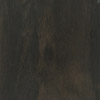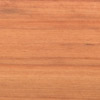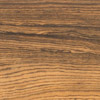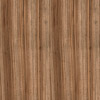| Maple. Maple is a standard fingerboard choice. Many varieties of maple are used, including flatsawn, quartersawn, flame, curly and Birdseye. Additionally, maple does very well when roasted – making for very attractive and stable fingerboards. We offer all of these choices on our custom necks! |  |
||||||||||||||||
|
Rosewood. Along with maple, rosewood is the one of the most common fingerboard woods. When paired with a mahogany neck, which has a warm, mellow tone, the rosewood fingerboard contributes to complex highs, thick and creamy lows, and an appealing midrange. When paired with maple necks, rosewood fretboards change the maple neck’s bright characteristic tonal properties to become a little warmer and sweeter. The maple provides sparkle in the highs with the rosewood mellowing the tone and thickening the lows. In addition to the tonal characteristics that the fingerboard imparts, it also changes the feel of the neck. A player’s choice of a maple fingerboard or rosewood fingerboard may be as much about feel or appearance as it is about tone. Rosewood is subject to CITES import and export restrictions. For this reason, we do not ship this wood outside of the USA. |
  |
||||||||||||||||
|
Ebony. A popular fingerboard upgrade option, the ebony fretboard provides more tightness, clarity, and definition, as compared to rosewood fingerboards. It is a very dense, hard wood, providing for a fast attack from the instrument. It offers a muscular, controlled bass, and snappy, sizzling highs. With a mahogany back contributing some warmth and openness to the brew, this can be a very appealing pairing. Ebony wears well. It doesn’t wear away after years of finger and string contact nearly as easily as rosewood does.
|
 |
||||||||||||||||
|
Walnut. Walnut is becoming a more popular choice for fingerboards. Walnut range from a lighter pale brown to a dark chocolate brown with darker brown streaks. Color can sometimes have a grey, purple, or reddish cast. Walnut is used for both neck shaft and fingerboards.
|
 |
||||||||||||||||
|
Cocobolo. Cocobolo offers a variety of colors, from yellow, orange, red, and shades of brown with streaks of black or purple. Colors are lighter when freshly cut, and darken with age. Cocobolo is a species of Rosewood. As such it is subject to CITES import and export restrictions. For this reason, we do not ship this wood outside of the USA.
|
 |
||||||||||||||||
|
Granadillo. Granadillo is a new name for many American guitarist and luthiers, but is fairly common in the trade in South America. It is non-porous, straight grained, very dense, and has a ringing, bright tap tone. The reddish-brown color will darken to a brick color over time much like Honduran Rosewood. This wood is also known as Macacauba, Macawood, Hormigo, and Orange Agate.
|
 |
||||||||||||||||
|
Pau Ferro. Pau Ferro is also known as Morado, Bolivian Rosewood, and Santos Rosewood. It varies widely in color, from reddish/orange to dark brown with black streaking. It typically has straight grain and a fine texture. The wood has been as a substitute for Brazilian Rosewood. Although the wood is not technically in the Dalbergia genus, it’s in a closely-related genus (Machaerium). This wood is not controlled by CITES so there are no import or export restrictions in place.
|
 |
||||||||||||||||
|
Bloodwood. Bloodwood is traditionally known by the name Satine. Bloodwood is a bright red color that will darken to a brownish red over time with exposure to light. Applying a thick finish and keeping the wood out of sunlight can help slow this change. Bloodwood grain is usually straight or slightly interlocked. Bloodwood is used for both neck shafts and for fingerboards.
|
 |
||||||||||||||||
|
Bocote. Bocote is a yellow brown with dramatic dark brown to black stripes. Color tends to darken with age. The grain patterning can be striking, particularly on flatsawn pieces. It is common to see many eyes and other figuring in Bocote.
|
 |
||||||||||||||||
|
Canarywood. Canarywood’s color can vary a fair amount, from a pale yellow-orange to a darker reddish brown, usually with darker streaks. Color tends to darken and streaking becomes less pronounced with age. Canarywood is used for neck shafts and for fingerboards.
|
 |
||||||||||||||||
|
Lacewood. Lacewood has prominent flecking that gives this wood its name. The wood is a reddish brown with grey or light brown rays, which result in a lace pattern when quartersawn. Lacewood has the most pronounced figure and displays the largest flecks when perfectly quartersawn.
|
 |
||||||||||||||||
|
Leopardwood. Leopardwood has prominent flecking that gives this wood its names. The wood is a medium to dark reddish brown with grey or light brown rays, which resemble the spots of a leopard. Leopardwood has the most pronounced figure and displays the largest flecks when perfectly quartersawn.
|
 |
||||||||||||||||
|
Padouk. Padouk’s color varies from pale pinkish orange to deep brownish red. Most pieces start reddish orange when cut, darkening substantially over time to a reddish/purplish. Padouk is used for neck shafts and for fingerboards.
|
 |
||||||||||||||||
|
Purpleheart. Purpleheart is a dull grayish/purplish brown when first cut. With light exposure, the wood becomes a deeper purple. With age and exposure to UV light, the wood becomes a dark brown with a hint of purple. This color-shift can be slowed and minimized by using a UV inhibiting finish on the wood. Purpleheart is used for neck shafts and for fingerboards.
|
 |
||||||||||||||||
|
Rocklite. Rocklite is a man made product, engineered entirely from real, sustainable wood. Rocklite is a semi synthetic wood with uniform grain and color characteristics. It is quite hard and works well for fingerboards. Please see http://www.rocklite.co.uk/ for details. |
 |
||||||||||||||||
|
Wenge. Wenge is medium brown, sometimes with a reddish or yellowish hue, with nearly black streaks. Upon application of a wood finish (particularly an oil finish) the wood can become nearly black. Wenge is used for both neck shafts and for fingerboards.
|
 |
||||||||||||||||
|
Zebrawood. Also known as Zebrano, Zebrawood is a light brown or cream color with dark blackish brown streaks vaguely resembling a zebra’s stripes. The stripes can be either chaotic and wavy when flatsawn, or somewhat uniform when quartersawn.
|
 |
||||||||||||||||
|
Ziricote. Ziricote ranges from medium to dark brown, often with either a green or purple hue and normally has darker bands of black growth rings. Ziricote has a very unique appearance, sometimes referred to as “spider-webbing” or “landscape” grain figure.
|
 |
||||||||||||||||
